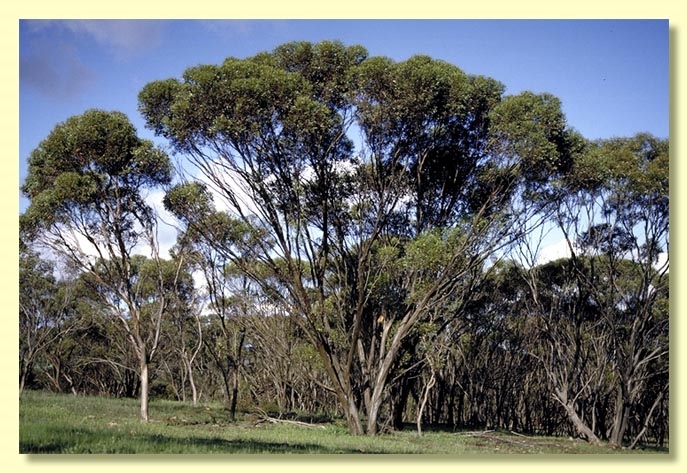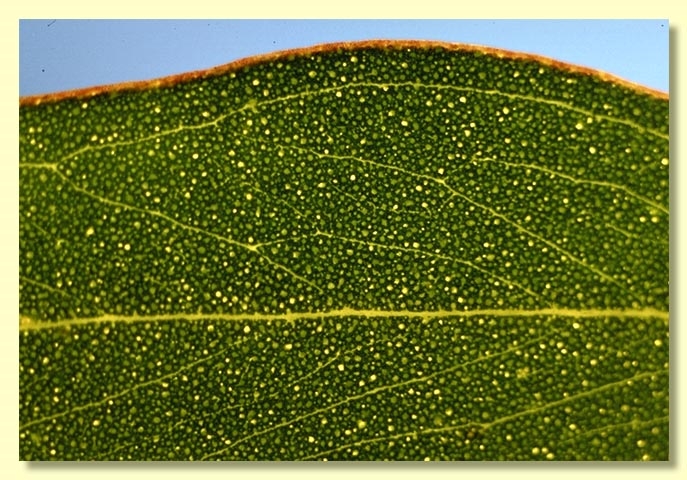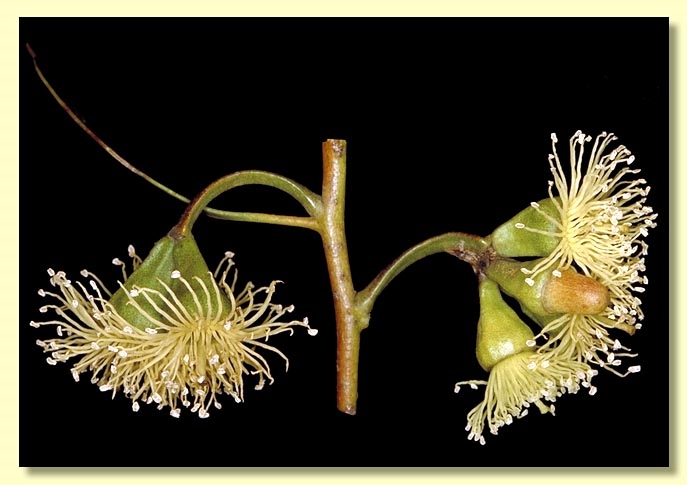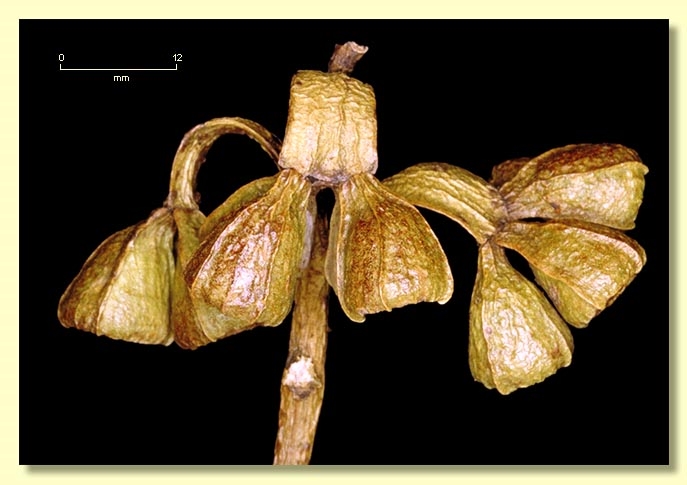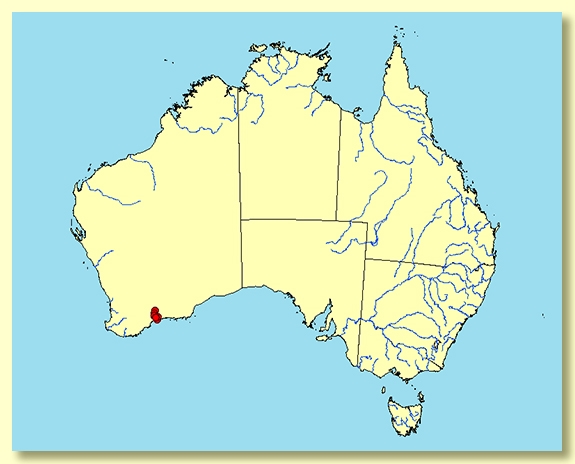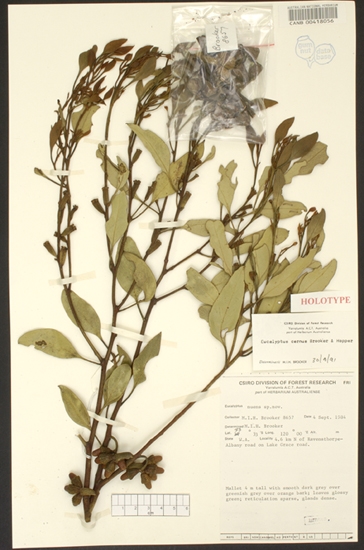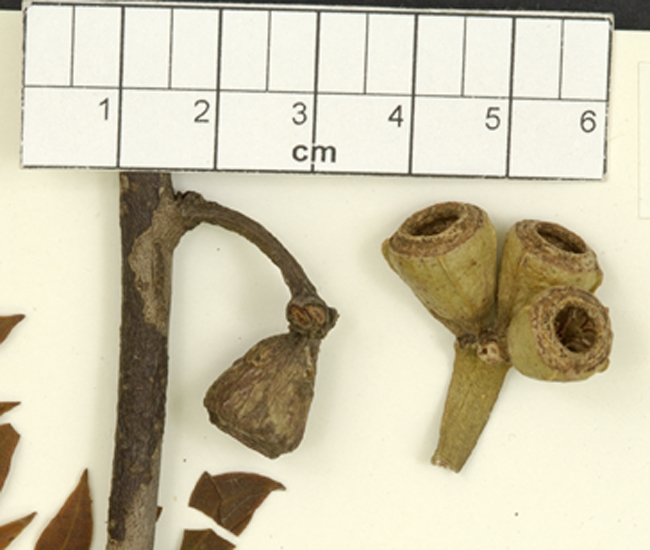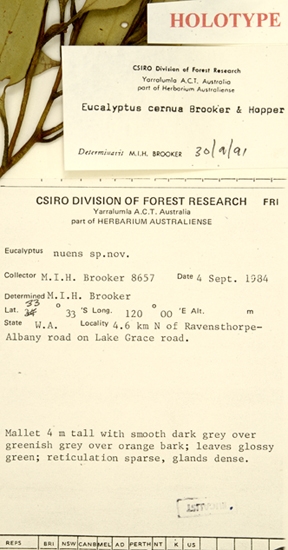Euclid - Online edition
Eucalyptus cernua
Eucalyptus | Symphyomyrtus | Bisectae | Glandulosae | Clinatae
Bark smooth throughout, dark grey to black over greenish yellow, shedding in strips.
Branchlets with oil glands in the pith.
Juvenile growth (coppice or field seedlings to 50 cm): not seen.
Adult leaves alternate, petioles 1.3–2.5 cm long; blade usually lanceolate, (4.2)5.5–8.3(9.5) cm long, (1.2)1.4–2.5(3.3) cm wide, base tapering to petiole, margin entire or rarely subcrenulate, apex pointed, concolorous, glossy, green, surface appearing "glazed", side-veins acute or obscure, reticulation obscure, intramarginal vein remote from margin, oil glands numerous.
Inflorescence axillary unbranched, peduncles broadly flattened, usually down-turned, 1.2–2.8 cm long, buds 7 per umbel, sessile to very shortly pedicellate (pedicels 0–0.4 cm long). Mature buds more or less ovoid (1–1.6 cm long, 0.6–1 cm wide), egg-in-eggcup, i.e. the operculum narrower than the hypanthium at the join, scar present (outer operculum shed very early), inner operculum rounded-conical, smooth, hypanthium with 2 prominent longitudinal ridges and often 1 or 2 less prominent ridges, stamens all inflexed but to varying degrees, anthers narrowly oblong, versatile, dorsifixed, dehiscing by longitudinal slits, style long and straight, stigma blunt, locules 5 or 6, the placentae each with 4 vertical rows of ovules. Flowers red, pink, yellow-green or greenish-cream.
Fruit sessile or subsessile (pedicel 0–0.5 cm long), obconical to campanulate, with 2–4 narrow longitudinal ridges, 0.9–1.4(1.7) cm long, 0.8–1.3(1.5) cm wide, rim broad, disc descending, valves 5 or 6, rim level or scarcely enclosed (visible).
Seeds grey-brown to brown, 1–2.5 mm long, flattened-ovoid, dorsal surface clearly but shallowly reticulate, hilum ventral.
Cultivated seedlings (measured at node 10): cotyledons Y-shaped (bisected); not grown yet beyond this stage.
E. cernua has been recorded flowering from October to December.
A mallet endemic to Western Australia, found only in and around the southern sub-coastal Ravensthorpe Range, Bandalup Hill and near Annie Peak in Fitzgerald River National Park, occurring in drainage lines on clayey gravelly soils. It has smooth bark and green, glossy "glazed" leaves, usually with visible side-veins but reticulation is obscured by numerous oil glands. Buds are in down-turned clusters and have a smooth operculum narrower than and slightly shorter than the base (hypanthium).
Eucalyptus cernua is distinguished from its closest relative, the mallee E. proxima, only by the lack of the lignotuber and low-lying habitat. E. proxima is more common on slopes and slightly raised areas of sandy gravelly soil south from the Ravensthorpe Range to Kundip and the Eyre Range. Both species have colourful flowers that may be shades of yellow, pink and red. To accurately separate the two species note will need to be made of habit and habitat as the bark, leaves, buds and fruit are similar. Another closely related mallet species found further west near Corackerup, E. vesiculosa, has profoundly warty opercula, broadly elliptical to sub-orbicular adult leaves. E. vegrandis, another closely related species from further west around Ongerup, has smaller buds that are at best weakly ridged and never prominently angled, conical operculum, linear to lanceolate leaves and mallee habit.
Eucalyptus cernua was published after the classification of the eucalypts published by Brooker (2000). Within that classification it is best placed in Eucalyptus subgenus Symphyomyrtus section Bisectae subsection Glandulosae because the buds have an operculum scar, cotyledons are bisected and branchlets have oil glands in the pith. Within this very large group (some 80 species) E. cernua is, however, only closely related to two other species, E. proxima and E. vesiculosa, and more distantly related to E. vegrandis. Together these 4 species form series Clinatae characterised by having angled buds with a short operculum narrower than the hypanthium, and inflexed stamens on a broad staminophore, leaves with many oil glands but not obscuring the main side-veins, and down-turned bud clusters.
The type specimen of E. cernua comes from a plant which is a mallet (small tree lacking a lignotuber); these mallets commonly have greenish to cream flowers, though plants with red to pink flowers do occur. The mallee E. proxima more commonly has red or pink flowers, rarely creamy-yellow flowers.
When Brooker & Hopper (2002) published the description of E. cernua they included both lignotuberous (mallee) and non-lignotuberous (mallet) forms under this name. Nicolle & Brooker (2005) separated the mallee and mallet entities within E. cernua as two distinct species. Because the type specimen of the name E. cernua was known to be taken from a non-lignotuberous plant a new name, Eucalyptus proxima, was erected to cater for the populations of plants that have lignotubers.
For many years the name Eucalyptus nutans F. Muell. was misapplied (collectively) to red-flowered plants of E. cernua and E. proxima, and was used in horticulture. However the type specimen of E. nutans represents a coastal species of mallet habit from Bremer Bay and east of Albany, well to the south-west of the now known distribution of E. cernua and E. proxima. Typical E. nutans has a similar mallet habit and adult leaf form to E. platypus and, like that species, has erect stamens within the bud.

